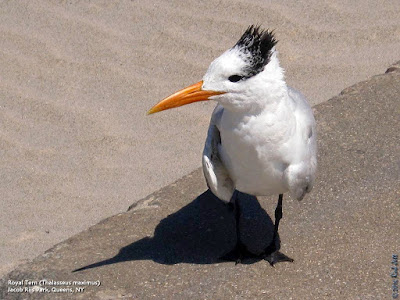Friday's Foto
The Royal Tern is our second largest tern after the similar Caspian Tern. Adults in breeding plumage are pale gray above and whitish below, palest on head and neck with a black cap. In flight they have a dark upper surface to outer primaries and dark-edged wingtips seen from below. Their relatively heavy, slender bill is orange, but ranges from yellow to reddish. Non-breeding adults and immature birds are similar, but shows only remnant of dark cap on nape.
Worldwide they have a very large range. Found in the Americas and the Atlantic coast of Africa. In Africa they breed from Mauritania to Guinea, ranging in winter from Morocco to Namibia. In the Americas they breed from southern California to Sinaloa, Mexico, from Maryland to Texas, through the West Indies to the Guianas and possibly Brazil, on the Yucatan Peninsula, in south Brazil, Uruguay and north Patagonia (Argentina). It winters from Washington south to Peru on the western coast, and from Texas to south Brazil on the eastern side (del Hoyo et al. 1996).
Due to their extremely large range and large populations the IUCN lists their conservation status as Least Concern.
Over the past few years small numbers of adult and juvenile Royal Terns have been observed through the summer at coastal locations around Brooklyn. In the final edition of "Bull's Birds of New York State" Michael F. Cooper writes, "As its breeding range has crept northward in recent decades, local observers eagerly await the first NY nesting. Adults are often seen feeding flying juveniles, but terns are notorious wanderers and continue to feed their young even in winter quarters, far in time and place from breeding sites. These sightings are not proof of breeding in our area." I'm guessing that somewhere on one of New York Harbor's island nesting colonies a Royal Tern nest is waiting to be discovered.
The Royal Tern’s scientific name, Thalasseus maximus, means greatest fisherman.
Worldwide they have a very large range. Found in the Americas and the Atlantic coast of Africa. In Africa they breed from Mauritania to Guinea, ranging in winter from Morocco to Namibia. In the Americas they breed from southern California to Sinaloa, Mexico, from Maryland to Texas, through the West Indies to the Guianas and possibly Brazil, on the Yucatan Peninsula, in south Brazil, Uruguay and north Patagonia (Argentina). It winters from Washington south to Peru on the western coast, and from Texas to south Brazil on the eastern side (del Hoyo et al. 1996).
Due to their extremely large range and large populations the IUCN lists their conservation status as Least Concern.
Over the past few years small numbers of adult and juvenile Royal Terns have been observed through the summer at coastal locations around Brooklyn. In the final edition of "Bull's Birds of New York State" Michael F. Cooper writes, "As its breeding range has crept northward in recent decades, local observers eagerly await the first NY nesting. Adults are often seen feeding flying juveniles, but terns are notorious wanderers and continue to feed their young even in winter quarters, far in time and place from breeding sites. These sightings are not proof of breeding in our area." I'm guessing that somewhere on one of New York Harbor's island nesting colonies a Royal Tern nest is waiting to be discovered.
The Royal Tern’s scientific name, Thalasseus maximus, means greatest fisherman.












1 comment:
Beautiful photo of this bird!
Post a Comment